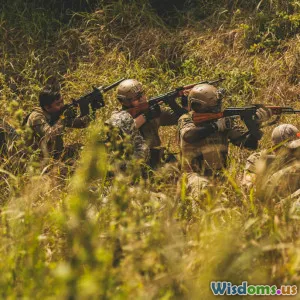
Collaborative Defense Strategies
9 min read Explore how collaborative defense strategies reshape military technology and future weapon innovations. (0 Reviews)
Collaborative Defense Strategies: The Future of Military Technology and Weapons
In a world where threats are increasingly global and complex, traditional military strategies are evolving. Collaborative defense strategies represent a shift in how nations approach security and warfare. This article explores the innovative technologies and treaties driving cooperation among armed forces worldwide, ensuring a multispectral approach to defense.
The Necessity for Collaborative Defense
Evolving Threats
With geopolitical tensions rising globally, from cyber warfare to conventional military confrontations, the modern battlefield is multifaceted. As examples like Russia's actions in Ukraine or China's assertive posture in the South China Sea demonstrate, threats now transcend national borders, requiring collaborative initiatives. According to a report by the Stockholm International Peace Research Institute (SIPRI), military spending has surged in numerous countries, with many investing in technology that underscores cooperation as a foundation for national defense.
Benefits of Collaboration
Collaborative defense strategies facilitate:
- Enhanced intelligence sharing.
- Joint training exercises and tactical planning.
- Economies of scale in procurement of military technologies.
As noted by General Joseph Dunford, former Chairman of the Joint Chiefs of Staff, "The complexity of the war environment demands strong partnerships to ensure effectiveness in our strategies." This emphasis highlights the need for unified approaches to navigate modern insecurity challenges.
Key Components of Collaborative Defense Strategies
Military Alliances and Treaties
Historically, alliances such as NATO have demonstrated the efficacy of collaborative defense strategies. Not only do these institutions provide a framework for joint action, but they also establish communication platforms among member states. For instance, the NATO Enhanced Forward Presence (eFP) in Eastern Europe serves as a tangible commitment to mutual defense against potential aggression from Russia, as outlined in NATO's 2020 Strategic Concept.
Joint Development of Technology
The development of new military technologies is an area where collaboration shines. For instance:
- The F-35 Lightning II program demonstrates how the U.S. led a partnership between multiple nations, including the UK, Israel, and other NATO allies, in developing advanced stealth fighter capabilities.
- The Eurofighter Typhoon project showcases a joint initiative among the UK, Germany, Italy, and Spain to create an advanced multirole fighter jet, marrying resources and expertise across borders.
In all these instances, cost-sharing and the pooling of intellectual resources have been paramount, resulting in cutting-edge technologies that bolster mutual defense capacities.
Integrated Defense Technologies
Cybersecurity Collaboration
As the cyber realm becomes a more prominent battlefield, collaborative cybersecurity strategies are essential. The Cybersecurity and Infrastructure Security Agency (CISA) in the U.S. emphasizes integrating protocols with international partners, aiding in shared tactics and rapid response capabilities against cyber threats.
Space Defense Collaborations
Space has transformed into an operational domain critical for defense strategies. Global initiatives, such as the Space Data Association (SDA), allow countries to share orbital data, ensuring both safety and operational effectiveness in space missions.
One notable evolution is the establishment of the Space Force in the U.S. military, where collaboration becomes invaluable. The forthcoming establishment of multinational organizations like the European Space Agency's Space Surveillance and Tracking program aims to sustain global logistics and joint defensive capabilities in this uncharted territory.
Informing Policy Through Data
Data-Driven Decision Making
Collaborative defense strategies support the collection and analysis of vast amounts of data regarding defense mechanisms and tactics in joint exercises. By harnessing artificial intelligence and machine learning, countries can inform their policies with quantitative data. Recent studies illustrate that militaries using collaborative frameworks see a 25% faster decision-making rate in tactical scenarios.
Improving Readiness and Resilience
Incorporating shared technology can substantially improve the readiness of allied forces. The U.S. Army, for instance, partnered with academic institutions to develop the Integrated Training Environment, allowing for realistic simulation exercises that include both American and allied forces. This fosters a deeper understanding of joint operations and enhances interoperability.
The Role of International Organizations
The United Nations and Peacekeeping Operations
International organizations like the UN play a vital role in facilitating collaborative defense strategies, particularly in peacekeeping operations. Missions, typically backed by a coalition of nations, require extensive cooperation. Reports indicate that nations engaged in peacekeeping yield 45% fewer casualties than operations uncoordinated and supported solely by one nation.
Regional Security Arrangements
Regional organizations such as the African Union (AU) and Organization for Security and Co-operation in Europe (OSCE) foster security cooperation. The AU's African Standby Force is an effort to improve a continent-wide collaborative defense strategy, aiming to effectively respond to regional crises. Similarly, OSCE’s focus on conflict prevention through dialogue promotion echoes the importance of cooperation among conflicting nations.
Future Sea Change in Military Collaboration
AI and Centralized Command and Control Systems
Looking ahead, collaborative defense strategies will seamlessly integrate advanced technologies like artificial intelligence (AI). The emergence of AI-powered centralized command and control systems could enhance real-time decision-making capabilities during conflicts, thereby enabling swift responses across coalition forces. Nations like the U.S. and Israel are leading investments in AI-integrated weaponry and platforms, which can collaborate automatically across different defense networks, offering a groundbreaking dimension to existing frameworks.
Imagining Warfare in the Future
The rise of distributed systems and autonomous weapons requires revisiting collaboration in the defense arena. Critical ethical and regulatory challenges await as technology can fulfill roles traditionally held by humans. As future weapons systems evolve, consensus-building among nations, even around contentious subjects, will be a priority to ensure global security.
Conclusion: Embracing a Unified Future in Defense
In an interconnected world with threats cloaked in complexity, collaborative defense strategies are becoming not only advantageous but necessitated. Emphasizing united actions, investments in technology, and rigorous engagement in dialogues will forge a robust international framework prepared to tackle emerging military challenges. From treaties that bind allied nations closer together to cooperative ventures in technological development, future military collaborations promise enhanced security and strength.
The key lies in utilizing these strategies to create not just powerful weaponry but resilient partnerships that form the bedrock of international peace and stability. As nations look towards the future, their ability to work together will define not only the course of warfare but the preservation of humanity in the face of adversity.
Rate the Post
User Reviews
Popular Posts





















